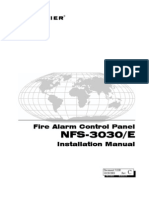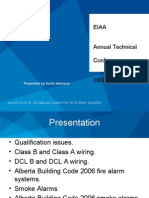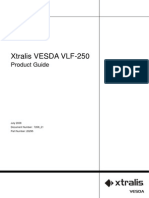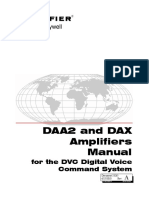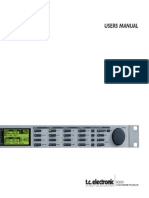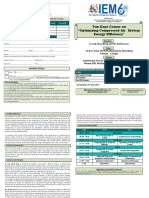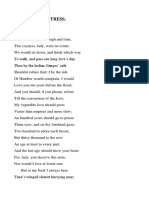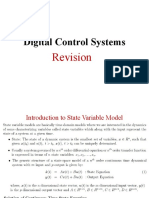VTT10000 Manual PDF
VTT10000 Manual PDF
Uploaded by
alekyaCopyright:
Available Formats
VTT10000 Manual PDF
VTT10000 Manual PDF
Uploaded by
alekyaOriginal Title
Copyright
Available Formats
Share this document
Did you find this document useful?
Is this content inappropriate?
Copyright:
Available Formats
VTT10000 Manual PDF
VTT10000 Manual PDF
Uploaded by
alekyaCopyright:
Available Formats
VESDA
VTT 100 User Manual
Australia and Asia
Vision Fire & Security
Private Bag 215
495 Blackburn Road
Mount Waverley, VIC,
3149 Australia
Ph
+61 3 9211 7200
Fax +61 3 9211 7201
Free Call 1 800 700 203
VESDA
VTT 100 User Manual
VESDA Test
Transformer
(VTT-100)
The Americas
Vision Fire & Security
700 Longwater Drive
Norwell, MA 02061, USA
Ph
+781 740 2223
Toll Free 800 229 4434
Fax
+781 740 4433
Test Transformer Guide
Europe and the Middle East
Vision Fire & Security
Vision House, Focus 31 Mark Road
Hemel Hempstead
Herts, HP2 7BW UK
Ph +44 1442 242 330
Fax +441442 249 327
www.vesda.com
Private and Confidential
February 2004
This document may not be reproduced, in whole or in part, by any means without the prior
express written permission of the copyright owner. Copyright 2003 Vision Fire & Security Pty
Ltd A.C.N. 008 009 514. The manufacturer reserves the right to change designs or
specifications without obligation and without further notice. VESDA, LaserTEKNIC, LaserPLUS,
LaserSCANNER, LaserCOMPACT, LaserFOCUS, VESDAnet, VESDAlink, ASPIRE, AutoLearn,
VSM, VConfig, InfoWORKS, PROACTIV, PRECISION and VSC are trademarks used under
licence by the distributor.
Part No.: 20333
Revision No. 03
VESDA
VTT 100 User Manual
VESDA
VTT 100 User Manual
Table of Contents
1.0
Introduction
2.0
Preparation and precautions
3.0
Equipment Set Up
4.0
Preparation and connection of the test wire
5.0
Smoke Test
6.0
References
7.0
Specification
8.0
Compliance
9.0
Ordering Information
VESDA
1.0
VTT 100 User Manual
VESDA
VTT 100 User Manual
Introduction
This Guide describes the use of the VESDA Test Transformer (VTT-100
previously known as the Hot Wire Test Power Supply Unit (PSU)) to test
very early warning aspirated smoke detection equipment. The unit provides
6VAC output from 220-240VAC or 110-120VAC mains supply. High current
is passed through a test cable in order to heat it, which causes its insulation
to burn giving off smoke. A timer is incorporated to provide a selectable
burn period of up to 3 minutes.
Note:
The timer also helps to prevent the unit being inadvertently left on for
an extended period. The unit must never be left on and unattended!
The rocker switch on the top of the unit is the on/off switch. When power is
applied and the unit is turned on the (green) POWER indicator on the
timer flashes and power is applied to the output terminals until the set time
has elapsed. Once the timer has timed out the output is switched off and
the (red) OUT indicator on the timer illuminates. The POWER indicator
then stops flashing and remains illuminated. The timer is reset when the
switch is turned off and will run for the full selected period when the switch
is turned on again.
Note:
The on/off switch may be illuminated while the unit is switched on.
This is not an indication that the output is active.
The unit must be operated for no more than three (3) minutes
continuously and must be left off immediately after operating for a period of
at least seven (7) minutes to allow it to cool.
Note:
The unit is protected against over-temperatures by a thermal switch.
Once tripped, the thermal switch will not allow operation for an
extended period (up to an hour) regardless of power being present
or not. The thermal switch cannot be bypassed or reset manually.
Part Number: VTT-10000
2.0
Preparation and precautions
When performing a hot wire test ensure that local standards and regulations
are understood and have been adhered to where applicable. Also, ensure
that the VESDA detection equipment being proved/tested is isolated from
both the local fire authority notification alerts and any suppressant actioning
devices.
WARNING - The hot wire test is intended to trigger a response from
the Aspirating Detector under test ensure that the
consequences of this activation are understood and
under control.
Precautions must also be taken to ensure that all people present are aware
that the test is being conducted and that those who are required to remain
in the immediate vicinity of the test are suitably attired for the smoke levels
about to be created.
WARNING - Avoid inhaling the smoke plume as it contains small
quantities of HCl.
The wire burn tests, particularly the 1m and 2 x 1m tests, produce
sufficiently high temperatures to generate small quantities of hydrogen
chloride. However, test personnel are unlikely to be exposed to
concentrations of hydrogen chloride that exceed the Occupational Exposure
Standard (OES) of 5ppm in a 15 minute period unless they are directly
exposed to the smoke plume.
VESDA
VTT 100 User Manual
VESDA
It is strongly recommended that personnel wear appropriate protective
equipment such as an E1 respirator confirming to EN140 and goggles,
without ventilation, conforming to EN166 under the following situations:
1.
2.
3.
4.
It is impractical to perform remote switching of the transformer.
Multiple tests are required.
Personnel are within the immediate vicinity (e.g. 2m) of the smoke
source.
VTT 100 User Manual
Turn the unit off and disconnect the power supply cord.
Eject the fuse drawer.
Remove the existing fuse and replace with one of the correct rating.
(See below.)
Reinsert the fuse drawer.
The timer must be in mode A with the scale set to min (minutes) and the
scale showing from 0 to 3 (maximum of three minutes operation). The
timer should appear like this:
Due to the nature of Hot Wire tests there is a minor fire hazard. It is
strongly recommended that an appropriate type of fire extinguisher (e.g.
CO2 or dry powder) is available during the test.
It is the responsibility of the person carrying out the tests that the electrical
equipment used is maintained at all times for safety. In particular, check
that the supply voltage selector is set appropriately, the correct fuse is fitted
for the selected voltage and that a power cord with suitable local approvals
is used.
If in doubt, please seek guidance from a suitably qualified electrician.
3.0
Equipment Set Up
CAUTION:
Ensure that the mains input voltage selector is set to suit
the supply voltage and the fuse fitted has the correct
rating.
If the voltage selector does not match the supply voltage in use then do the
following:
1.
2.
3.
4.
If the timer does not match this picture then do not operate the unit.
Contact VESDA support to resolve this issue.
It is recommended to confirm the accuracy of the burn period using a
stopwatch and a suitable multimeter connected to the output terminals
before conducting any live tests. If this is necessary, seek guidance from a
suitably qualified electrician.
Remotely switching power to the VTT-100 from the mains outlet can assist
in the reduction of possible smoke inhalation by personnel.
Turn the unit off and disconnect the power supply cord.
Using a screwdriver, undo the screws that hold the transparent cover
in place and remove the cover.
Select the correct voltage (to match your supply) on the selector
switch.
Replace the transparent cover and redo the cover screws.
If the fuse is not the correct rating for the supply voltage in use then do the
following:
Applicable code wire burn recommendations:
VESDA
VTT 100 User Manual
BS6266:1992 recommends a burn time of 60s for one metre wire
lengths and 180s for 2 metres.
The NFPA 76 code also recommends the same tests with an
additional test with a burn time of 60s using 2 x 1m wires connected
in parallel.
VESDA
5.0
VTT 100 User Manual
Smoke Test
Ensure that the local fire panel is isolated from the external fire reporting
equipment and that any automatic extinguishing or suppressant systems
are similarly isolated.
Connect power to the VTT-100 and turn the switch on.
Preparation and connection of the test
wire
At this point, there is 6VAC applied across the test wire, the switch will
illuminate and the green indicator on the timer will begin to flash. The test
wire will become hot and a small quantity of smoke will be generated.
The test wire samples should be carefully measured and cut to the required
length. The ends should be stripped at approximately 15mm using a
suitable tool. If in doubt, please seek guidance from a suitably qualified
electrician.
WARNING - The test wire becomes very hot during the test and will
cause burns if held in the hand. Care must be taken
throughout this test process.
4.0
WARNING - Only use the recommended test wire.
Under no circumstances should test wires be shorter
than 60cm or 2x1m in parallel.
This is likely to age (or blow) the inlet fuse and may
cause an unnecessary inconvenience.
Ensure that no power is connected to the VTT-100. Insert the test wire
between the output terminals and lay it on a supporting non-combustible
platform. It is important to ensure that there are no cross overs of the wire.
It may be helpful to first coil the wire using a pen or pencil as a temporary
former and then lay it out.
Alternatively, an arrangement to support the wire may be used with the
precaution of a fire blanket positioned beneath the wire.
If the equipment is in a high airflow area then it may be required to shield
the wire from the airflow.
WARNING - At no time is it appropriate to open the VTT-100. There
are no user-serviceable parts inside.
Turn the unit off after the timed burn period is complete.
Smoke shall be generated and the time for the detection should be
recorded to ensure that transport and alarm times are within the local
regulatory requirements.
6.0
References
Note that appropriate guidance should be noted to the local and applicable
standards and regulations such as the following:
BS5389 Part1: 2002
BS6266:1992
BS6266:2002 (which cross references to the BFPSA Code of Practice)
NFPA 76 :2002
BFPSA Code of Practice for Category 1 Aspirating detection systems,
Appendix A.
This Appendix is published on the BFPSA website at www.bfpsa.org.uk.
BFPSA British Fire Protection Systems Association.
VESDA
7.0
VTT 100 User Manual
Specification
Type:
Voltage Input:
Input Rating:
Fuse:
Output:
Operating Time:
Protection:
9.0
VTT-10000
220-240VAC, 50Hz or 110-120VAC, 60Hz
800mA @ 240VAC, 50Hz, 1.6A @ 120VAC, 60Hz
220-240VAC, 800mA(T) (Anti-surge)
110-120VAC, 1.6A(T) (Anti-surge)
6VAC nominal, 20A
Maximum on time: 3 minutes (180 seconds)
Minimum off time between tests: 7 minutes (420
seconds)
IP30
Indoor use only.
This product is not to be used in the presence of moisture.
8.0
Compliance
Safety:
EMC:
VESDA
EN 61558-1:1997 Safety of power transformers, power
supply units and similar
EN 61558-2-6:1997 Particular requirements for safety
isolating transformers for general use
EN 50081-1 EMC-Generic Emissions
EN 50082-1 EMC-Generic Immunity
FCC Part 15 Class A Emissions
Ordering Information
VESDA Part Numbers:
VTT-10000
VTT-10000-AUS
VTT-10000-UK
VTT-10000-EUR
VTT-10000-USA
VTT 100 User Manual
Australia
United Kingdom
Europe
United States
251-001 Test Wire - 100m length.
The wire has the following technical specifications:
10/0.1 mm strands insulated with PVC to a radial thickness of 0.3mm and
2
the cross sectional area of the conductor being 0.078mm .
All parts can be ordered from your local VESDA distributor.
Further Information
Contact your nearest Vision Fire & Security office or distributor for further
information.
For users in the USA:
This device complies with Part 15 of the FCC Rules. Operation is subject to
the following two conditions: (1) this device may not cause harmful
interference, and (2) this device must accept any interference received,
including interference that may cause undesired operation.
For users Europe, Australia and/or New Zealand:
Warning -
This is a class A product. In a domestic environment this
product may cause radio interference in which case the
user may be required to take adequate measures.
You might also like
- GST 200 Operating Instruction: Following An ALARM or FAULT ConditionNo ratings yetGST 200 Operating Instruction: Following An ALARM or FAULT Condition6 pages
- A Study On Consumer Preferance Towards Sony Television in Tirupur100% (1)A Study On Consumer Preferance Towards Sony Television in Tirupur69 pages
- 1.1.0 General Description of VESDA Aspirating Smoke Detection System100% (1)1.1.0 General Description of VESDA Aspirating Smoke Detection System9 pages
- 06 Xtralis VESDA SDM Communications Guide A4 LoresNo ratings yet06 Xtralis VESDA SDM Communications Guide A4 Lores18 pages
- Installation Manual: Liquid Crystal DisplayNo ratings yetInstallation Manual: Liquid Crystal Display53 pages
- Addressable Charger-Power Supply ACPS-610-E ManualNo ratings yetAddressable Charger-Power Supply ACPS-610-E Manual56 pages
- Xtralis VESDA LCD Programmer Product Guide A4 LoresNo ratings yetXtralis VESDA LCD Programmer Product Guide A4 Lores54 pages
- Auxiliary Power Supply APS2-6R-E Instruction ManualNo ratings yetAuxiliary Power Supply APS2-6R-E Instruction Manual32 pages
- 4.4 Mounting VESDA Pipe Network Installation Guide.100% (1)4.4 Mounting VESDA Pipe Network Installation Guide.40 pages
- Apollo Marinecatalogue2013 All Mr-LockedNo ratings yetApollo Marinecatalogue2013 All Mr-Locked0 pages
- Qsimplex: 4100 Graphic Drive Assemblies Installation InstructionsNo ratings yetQsimplex: 4100 Graphic Drive Assemblies Installation Instructions4 pages
- NCM-W, NCM-F Onyx®: Series Network Communications ModulesNo ratings yetNCM-W, NCM-F Onyx®: Series Network Communications Modules2 pages
- DAA2 and DAX Amplifiers Manual - For The DVC Digital Voice Command System 53265No ratings yetDAA2 and DAX Amplifiers Manual - For The DVC Digital Voice Command System 53265130 pages
- All Modules - NFS2-3030V26.1 - Notifier VeriFire Tools 10.55 Build 19 - 08052020 - 111311No ratings yetAll Modules - NFS2-3030V26.1 - Notifier VeriFire Tools 10.55 Build 19 - 08052020 - 11131110 pages
- EST - QS4 Fire Alarm Control Panel Technical Reference Manual PDFNo ratings yetEST - QS4 Fire Alarm Control Panel Technical Reference Manual PDF138 pages
- ProReact Digital LHD Installation InstructionsNo ratings yetProReact Digital LHD Installation Instructions11 pages
- AN12 09 01 VeriFire - Tools 6 - 80 Licensing - OverviewNo ratings yetAN12 09 01 VeriFire - Tools 6 - 80 Licensing - Overview3 pages
- Proinert® Cylinder Completer Kit - Ig-541No ratings yetProinert® Cylinder Completer Kit - Ig-5412 pages
- 10 VESDA Pipe Network Design Guide A4 IE LoresNo ratings yet10 VESDA Pipe Network Design Guide A4 IE Lores56 pages
- Conventional Photoelectric Smoke Detector D-C401No ratings yetConventional Photoelectric Smoke Detector D-C4012 pages
- Fire Alarm Control Panel: M/S Firepro Systems PVT LTD, BangaloreNo ratings yetFire Alarm Control Panel: M/S Firepro Systems PVT LTD, Bangalore1 page
- ZP2-F Series Fire Alarm Control Panel Operation Manual: P/N 501-405203-2-20 - REV 2.0 - ISS 03MAR11No ratings yetZP2-F Series Fire Alarm Control Panel Operation Manual: P/N 501-405203-2-20 - REV 2.0 - ISS 03MAR1132 pages
- ESSER Honeywell Cat2011 008-030 Iq8control CentraleNo ratings yetESSER Honeywell Cat2011 008-030 Iq8control Centrale23 pages
- BCC8002 BC8002 Advanced Mainboard: Building TechnologiesNo ratings yetBCC8002 BC8002 Advanced Mainboard: Building Technologies4 pages
- Job Safety Analysis Sheet: Arc Welding, Cutting, GrindingNo ratings yetJob Safety Analysis Sheet: Arc Welding, Cutting, Grinding1 page
- Confined Space Entry Instructions Version 1 3 23042009 PDFNo ratings yetConfined Space Entry Instructions Version 1 3 23042009 PDF9 pages
- Etp-03 Test Procedure For Oil Filled TransformerNo ratings yetEtp-03 Test Procedure For Oil Filled Transformer2 pages
- Two-Days Course On "Optimizing Compressed Air System Energy Efficiency"No ratings yetTwo-Days Course On "Optimizing Compressed Air System Energy Efficiency"2 pages
- Qra For Grade Five Isito Level 2022 2023No ratings yetQra For Grade Five Isito Level 2022 2023209 pages
- VIT Bhopal Course and Fee Details 2019 20No ratings yetVIT Bhopal Course and Fee Details 2019 202 pages
- Exam Sem 1, 2014 Questions and Answers - PDF Exam Sem 1, 2014 Questions and Answers PDFNo ratings yetExam Sem 1, 2014 Questions and Answers - PDF Exam Sem 1, 2014 Questions and Answers PDF24 pages
- Vice President Manufacturing Operations in Chicago IL Resume Timothy KelleherNo ratings yetVice President Manufacturing Operations in Chicago IL Resume Timothy Kelleher2 pages
- Generating Spatial Audio From Portable ProductsNo ratings yetGenerating Spatial Audio From Portable Products3 pages
- Murach s Oracle SQL and PL SQL for Developers 2nd Edition Joel Murach 2024 scribd download100% (2)Murach s Oracle SQL and PL SQL for Developers 2nd Edition Joel Murach 2024 scribd download77 pages
- Operate An Automated Information System: D2.TTA - CL2.14 D2.TGA - CL6.06 Trainee Manual100% (2)Operate An Automated Information System: D2.TTA - CL2.14 D2.TGA - CL6.06 Trainee Manual154 pages
- Echoes of Eco: Green Rameshwaram: The Model-INo ratings yetEchoes of Eco: Green Rameshwaram: The Model-I7 pages
- GST 200 Operating Instruction: Following An ALARM or FAULT ConditionGST 200 Operating Instruction: Following An ALARM or FAULT Condition
- A Study On Consumer Preferance Towards Sony Television in TirupurA Study On Consumer Preferance Towards Sony Television in Tirupur
- 1.1.0 General Description of VESDA Aspirating Smoke Detection System1.1.0 General Description of VESDA Aspirating Smoke Detection System
- 06 Xtralis VESDA SDM Communications Guide A4 Lores06 Xtralis VESDA SDM Communications Guide A4 Lores
- Addressable Charger-Power Supply ACPS-610-E ManualAddressable Charger-Power Supply ACPS-610-E Manual
- Xtralis VESDA LCD Programmer Product Guide A4 LoresXtralis VESDA LCD Programmer Product Guide A4 Lores
- Auxiliary Power Supply APS2-6R-E Instruction ManualAuxiliary Power Supply APS2-6R-E Instruction Manual
- 4.4 Mounting VESDA Pipe Network Installation Guide.4.4 Mounting VESDA Pipe Network Installation Guide.
- Qsimplex: 4100 Graphic Drive Assemblies Installation InstructionsQsimplex: 4100 Graphic Drive Assemblies Installation Instructions
- NCM-W, NCM-F Onyx®: Series Network Communications ModulesNCM-W, NCM-F Onyx®: Series Network Communications Modules
- DAA2 and DAX Amplifiers Manual - For The DVC Digital Voice Command System 53265DAA2 and DAX Amplifiers Manual - For The DVC Digital Voice Command System 53265
- All Modules - NFS2-3030V26.1 - Notifier VeriFire Tools 10.55 Build 19 - 08052020 - 111311All Modules - NFS2-3030V26.1 - Notifier VeriFire Tools 10.55 Build 19 - 08052020 - 111311
- EST - QS4 Fire Alarm Control Panel Technical Reference Manual PDFEST - QS4 Fire Alarm Control Panel Technical Reference Manual PDF
- AN12 09 01 VeriFire - Tools 6 - 80 Licensing - OverviewAN12 09 01 VeriFire - Tools 6 - 80 Licensing - Overview
- Fire Alarm Control Panel: M/S Firepro Systems PVT LTD, BangaloreFire Alarm Control Panel: M/S Firepro Systems PVT LTD, Bangalore
- ZP2-F Series Fire Alarm Control Panel Operation Manual: P/N 501-405203-2-20 - REV 2.0 - ISS 03MAR11ZP2-F Series Fire Alarm Control Panel Operation Manual: P/N 501-405203-2-20 - REV 2.0 - ISS 03MAR11
- ESSER Honeywell Cat2011 008-030 Iq8control CentraleESSER Honeywell Cat2011 008-030 Iq8control Centrale
- BCC8002 BC8002 Advanced Mainboard: Building TechnologiesBCC8002 BC8002 Advanced Mainboard: Building Technologies
- Job Safety Analysis Sheet: Arc Welding, Cutting, GrindingJob Safety Analysis Sheet: Arc Welding, Cutting, Grinding
- Confined Space Entry Instructions Version 1 3 23042009 PDFConfined Space Entry Instructions Version 1 3 23042009 PDF
- Two-Days Course On "Optimizing Compressed Air System Energy Efficiency"Two-Days Course On "Optimizing Compressed Air System Energy Efficiency"
- Exam Sem 1, 2014 Questions and Answers - PDF Exam Sem 1, 2014 Questions and Answers PDFExam Sem 1, 2014 Questions and Answers - PDF Exam Sem 1, 2014 Questions and Answers PDF
- Vice President Manufacturing Operations in Chicago IL Resume Timothy KelleherVice President Manufacturing Operations in Chicago IL Resume Timothy Kelleher
- Murach s Oracle SQL and PL SQL for Developers 2nd Edition Joel Murach 2024 scribd downloadMurach s Oracle SQL and PL SQL for Developers 2nd Edition Joel Murach 2024 scribd download
- Operate An Automated Information System: D2.TTA - CL2.14 D2.TGA - CL6.06 Trainee ManualOperate An Automated Information System: D2.TTA - CL2.14 D2.TGA - CL6.06 Trainee Manual







